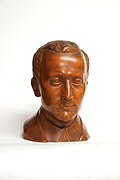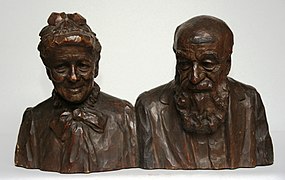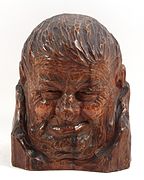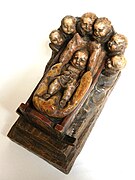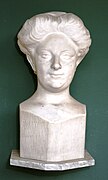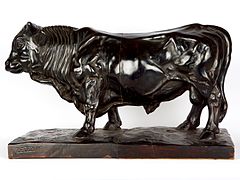Franz Zelezny
Franz Theodor Zelezny (born August 6, 1866 in Vienna ; † November 8, 1932 there ) was an Austrian sculptor.
Life
Franz Zelezny was the son of the wood sculptor Franz Xaver Zelezny, who came from Bohemia to Vienna during the Ringstrasse era in the middle of the 19th century .
Franz Zelezny was familiar with the technique of wood carving from a young age - grown up in his father's workshop. He studied from 1880 to 1883 at the Vienna State Trade School - today's successor institution HTL - with Professors Carl Hesky and Julius Deininger . He finished his studies at the State Trade School with the sculptor Anton Brenek .
After completing his training, he worked for his father for several years and at the end of the 1880s, following old craftsmanship, embarked on a long journey that took him to Paris via Munich , Augsburg , Ulm , Stuttgart and Strasbourg . In these cities his greatest interest was in the works of the old carvers, from Veit Stoss to Tilman Riemenschneider and Michael Pacher .
In 1891 he set up his own business in Vienna, exhibiting in the Künstlerhaus from 1892 to 1896 , in November 1898 in the Secession and from 1898 to 1907 in the winter exhibitions of the Austrian Museum of handcrafted wood carvings and figurines. In 1900 he took part in the Paris World Exhibition , where he received a gold medal for his works. He also took part in the International Decorative Arts Exhibition in Turin in 1902 and the Austrian Exhibition in London . From 1903 to 1926 he was represented in the exhibitions of the Künstlerhaus, of which he joined as a member in 1904. Since 1907 he also belonged to the Dürerbund , later to the Austrian Artists 'Association (founding member), the Wachau Artists' Association and the Marchfeld Art Community .
In 1907 he was appointed professor at the woodworking school in Villach , but resigned this teaching post in 1908 and returned to Vienna as a freelance artist.
Act
As a sculptor, Zelezny mastered any material, but did his best in the field of wood sculpture, where his inexhaustible imagination, his healthy sense of humor and his folk manner were best shown to advantage. The famous architect Adolf Loos called him “the greatest ornamental wood sculptor of our time, the greatest of all living wood cutters”.
He created two reliquary busts of Popes Sixtus and Urban (1902) for St. Stephen's Cathedral in Vienna . For the emergency church at the spinner on the cross (Vienna X) the wooden sculptures of the facade and the interior decoration (1916).
He also liked to put portraits of personalities on his church sculptures. The 14 stations of the cross in the St. Michaelskirche in Heiligenstadt (Vienna XIX) contain over 100 portraits of well-known Viennese personalities. In the Rosary Church on Marschallplatz in Vienna, Zelezny created the polychrome cross-path reliefs on the nave walls, the reliefs of the side altars, the pulpit and the Lourdes group (1909). The Herz Jesu Altar and other interior objects are also by Franz Zelezny.
He created the war memorial (1926) for the Wall near Vienna and the “Mariazeller Cross” for the outside of the Klosterneuburg collegiate church . Franz Zelezny also designed the warrior graves in Mistelbach, Ladendorf and Schleinbach.
In the First World War he created the defense shield for the armored cruiser of the kuk Kriegsmarine SMS Sankt Georg (1915). On this cruiser his son Walter Zelezny (1893-1977) was embarked, who became known through a special mission (1916) as a naval aviator in the First World War.
On the Wegscheid in Krems his "Simandl-Brunnen" was built in 1928 from Mannersdorfer Stein . In 1921 he furnished the Café Krantz in Vienna with a carved wooden arch rich in figures and reliefs. Out of the large number of his portrait busts and statuettes, the statue of Empress Elisabeth (1905), the statuettes of the dancers Isadora Duncan (1904), Maud Allan and Ruth St. Denis (1908) and other well-known personalities stand out. The depiction of the child's body occupies a large space among Zelezny's genre-like sculptures. Again and again he carved putti in wood and ivory.
Zelezny also employed the wealthy Viennese bourgeoisie. For example, Franz Zelezny created the final resting place of the Gerngroß family in the Central Cemetery in Vienna and the grave of the Marcus family in the Döblinger Friedhof .
Franz Zelezny was also known abroad. The city of Omaha in the US state of Nebraska ordered a President Lincoln memorial and the Queen of Romania a funeral memorial from him. A very important client was the Romanian royal family, which in Zelezny not just about Bernhard Hieronymus Ludwig ornamental carvings for their Royal Castle in Sinaia was in the Southern Carpathians, but also several figural sculptures commissioned.
The large carpentry workshops in Vienna, Bernhard Hieronymus Ludwig , Sigmund Jaray and, last but not least, the furniture manufacturer Michael Niedermoser, had pieces of furniture, but also complete living room, bedroom and dining room furnishings fitted out with carvings by Zelezny. Joseph Maria Olbrich , the builder of the Secession, Josef Hoffmann , Robert Oerley and Hans Prutscher were among Zelezny's customers.
Wolkersdorf , where his house and studio stood, he dedicated a number of other works. He adorned his house with a frieze (artist heads and putti, 1925). In the park of Wolkersdorf Zelezny created the portrait relief (1925) of Friedrich Schiller and the Kaiser-Franz-Joseph monument erected in 1908 , as well as several "house signs" such as the relief "The Holy Trinity" at the pharmacy in Wolkersdorf and the "rabbit picture" at former home of the former Haas master builder dynasty. He is the namesake of Franz Zelezny-Gasse in Wolkersdorf in the Weinviertel.
Literature and Sources
- Altmann, Ferdinand: Prof. Franz Zelezny , in: Manfred H. Bauch: Visual artists in and around Wolkersdorf 1900 to 2013 . Horn 2014.
- Ankwicz, Hans von: Sculptor Franz Zelezny , in: General Lexicon of Fine Arts from Antiquity to the Present . Edited by Hans Vollmer, Volume 36, Leipzig 1947.
- Bilger, Ferdinand: Professor Franz Zelezny , in: Österreichs Illustrierte Zeitung. 17th year. Issue 1. Vienna, October 6, 1907.
- Loos, Adolf: The sculptor Franz Zelezny. On the artist's 60th birthday , in: Austria's Bau- und Werkkunst. 2nd year. Vienna 1926.
- Roeßler, Arthur: Franz Zelezny. An attempt at characterization , in: Die Kunst für Alle, Volume 30 (1914–1915), Issue 11/12 (March 1, 1915). Munich 1914 to 1915.
- Roeßler, Arthur: Meister Franz Zelezny , in: Die Wage, Vienna October 15, 1921.
- Roeßler, Arthur: Sculptor Franz Zelezny , Vienna 1926.
- Roeßler, Arthur: Master Franz Zelezny. A commemorative sheet for the artist's 60th birthday , in: Bühne, Welt und Mode. Illustrated weekly supplement to Wiener Neuesten Nachrichten. No. 40. Vienna, August 1, 1926.
- Roeßler, Arthur: The carver Franz Zelezny. On the artist's 60th birthday , in: Der getreue Eckart. Half-monthly publication for the German house. 3rd year, 2nd volume, 21st issue. Vienna 1925/26.
- City of Wolkersdorf in the Weinviertel (media owner): Franz Zelezny. Sculptor and face carver from Wolkersdorf . Text: Friedrich Grassegger and Ferdinand Altmann. Catalog for the exhibition in Schloss Wolkersdorf "Von Engerln und Fidelen Lumpen". Wolkersdorf im Weinviertel 1997.
- Stoitzner, Konstantin: Sculptor Franz Zelezny , in: Oesterreichische Illustrierte Rundschau. 3rd year, number 1. Vienna, October 1, 1915.
Web links
- Entry about Franz Zelezny (Belvedere Vienna)
- Arthur Roeßler: Franz Zelezny - An attempt to characterize Heidelberg University Library
Individual evidence
- ^ Franz Xaver Zelezny; born November 16, 1836 in Český Šternberk (Bohemian Sternberg); died July 13, 1911 in Wolkersdorf in the Weinviertel
- ^ The furniture from 1898 , October 9, 1898 (wikisource)
- ^ Walter Zelezny, Sinking of the submarine "Foucault" , on doppeladler.com (platform for Austria's military history), accessed on August 20, 2015
- ^ Franz Zelezny: Portrait of the dancer Ruth St. Denis , Art Fair Fulda 2013
| personal data | |
|---|---|
| SURNAME | Zelezny, Franz |
| ALTERNATIVE NAMES | Zelezny, Franz Theodor |
| BRIEF DESCRIPTION | Austrian sculptor |
| DATE OF BIRTH | August 6, 1866 |
| PLACE OF BIRTH | Vienna |
| DATE OF DEATH | November 8, 1932 |
| Place of death | Vienna |

